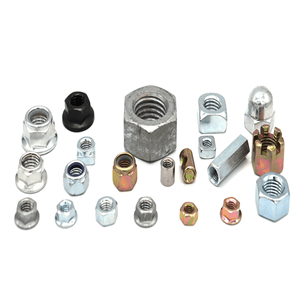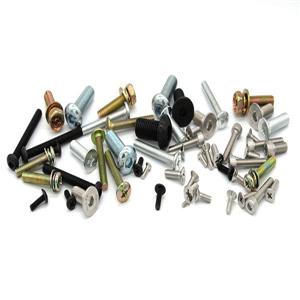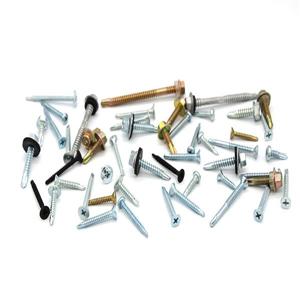Introduction of stainless steel fasteners (1)
Category editor
Stainless steel standard fasteners usually include the following 12 types of parts:
1. Bolt: A type of fastener consisting of a head and a screw (a cylinder with external threads), which need to cooperate with a nut to fasten two parts with through holes. This type of connection is called a bolted connection. If the nut is unscrewed from the bolt, the two parts can be separated, so the bolt connection is a detachable connection.
Stainless steel fasteners
Stainless steel fasteners
2. Stud: There is no head, only a type of fastener with external threads at both ends. When connecting, one end must be screwed into the part with the internal threaded hole, the other end is passed through the part with the through hole, and then the nut is screwed on, even if the two parts are firmly connected as a whole. This type of connection is called a stud connection and is also a detachable connection. It is mainly used in the case where one of the connected parts has a large thickness, requires a compact structure, or is not suitable for bolt connection due to frequent disassembly.
3. Screw: It is also a type of fastener consisting of the head and the screw. It can be divided into three categories according to its purpose: machine screws, set screws and special-purpose screws. Machine screws are mainly used for a tight connection between a threaded hole part and a part with a through hole, and do not require a nut. (This connection type is called a screw connection, which is also a detachable connection; it can also be Cooperate with the nut for the fastening connection between two parts with through holes.) Set screws are mainly used to fix the relative position between the two parts. Special-purpose screws such as eyebolts are used for lifting parts.
4. Stainless steel nuts: with internal threaded holes, generally in the shape of a flat hexagonal column, and also a rectangular or cylindrical shape, with bolts, studs or machine screws, used to fasten two parts, Make it a whole. Special category of nuts
High-strength self-locking nuts are a classification of self-locking nuts, which have a high strength and a high reliability. It is mainly the introduction of European technology as a prerequisite for road construction machinery, mining machinery, vibration machinery and equipment. At present, there are very few domestic manufacturers of such products.
Nylon self-locking nut Nylon self-locking nut is a new type of high-vibration and anti-loose fastening parts, which can be used in various mechanical and electrical products with a temperature of -50 to 100 ° C. At present, the demand for nylon self-locking nuts in aerospace, aviation, tanks, mining machinery, automobile transportation machinery, agricultural machinery, textile machinery, electrical products and various types of machinery has increased sharply because of its greatly high resistance to vibration and loosening. In various other
Anti-loosening device, and the vibration life is several times or even dozens of times higher. More than 80% of the current accidents in machinery and equipment are caused by loose fasteners, especially in mining machinery, and
The use of nylon self-locking nuts can prevent major accidents caused by loose fasteners.
5. Self-tapping screws: Similar to machine screws, but the thread on the screw is a special thread for self-tapping screws. It is used to fasten and connect two thin metal members into one piece. Small holes must be made in advance on the member. Because this screw has high hardness, it can be screwed directly into the hole of the member to make the member Form a responsive internal thread. This type of connection is also a detachable connection.
6. Wood screw: It is similar to machine screw, but the thread on the screw is a special rib for wood screw, which can be directly screwed into the wooden member (or part), and used to put a metal (or non-metal) with a through hole. The parts are fastened to a wooden member. This connection is also a detachable connection.
7. Washer: a type of fastener with a flat circular ring shape. It is placed between the support surface of the bolt, screw or nut and the surface of the connected part, which plays the role of increasing the contact surface area of the connected part, reducing the unit area pressure and protecting the surface of the connected part from being damaged; another type of elastic washer, It can also play a role in preventing the nut from loosening.
8. Retaining ring: It is installed in the shaft groove or hole groove of the machine and equipment, and plays a role of preventing the parts on the shaft or hole from moving left and right.
9. Pin: It is mainly used for positioning parts, and some can also be used for parts connection, fixing parts, transmitting power or locking other fasteners.
10. Rivet: A type of fastener consisting of the head and the nail rod, used to fasten the two parts (or components) with through holes to make it a whole. This type of connection is called rivet connection, or riveting for short. Is a non-detachable connection. Because the two parts connected together must be separated, the rivets on the parts must be destroyed.
11. Combination and connection pair: Combination refers to a type of fasteners supplied in combination, such as the combination of a certain type of machine screw (or bolt, self-supplied screw) and a flat washer (or spring washer, lock washer); connection Vice refers to a class of fasteners that are supplied with a combination of certain special bolts, nuts and washers, such as steel structures with high-strength large hexagon head bolts connected to the vice.
12. Welding nail: Due to the heterogeneous fastener composed of light energy and the nail head (or no nail head), it is fixedly connected to a part (or component) by welding in order to connect with other stainless steel standard parts. .




